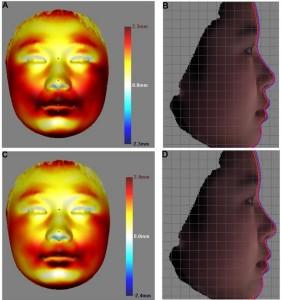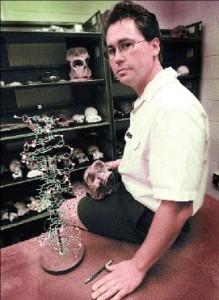Every year thousands of major crimes go unsolved. Imagine if police could gather DNA evidence at a crime scene, and within minutes to hours, turn that sample into a 3D model of the persons face that the DNA belongs  to. Police would then be able to know very accurately what that person looks like, from just about every angle. This is actually what one researcher named Mark Shriver of Pennsylvania State University has been working on.
to. Police would then be able to know very accurately what that person looks like, from just about every angle. This is actually what one researcher named Mark Shriver of Pennsylvania State University has been working on.
Over the last several months Shriver and his team have been gathering 3d images of over 600 volunteers. They then use those images to superimpose 7,000 different points of reference from facial features. The millions of points are then fed into a computer program which finds similarities between DNA, race, sex, and those facial features. Shriver found that 20 genes with just 24 variants were very reliable indicators of what a person’s facial shape is.
“Results on a set of 20 genes showing significant effects on facial features provide support for this approach as a novel means to identify genes affecting normal-range facial features and for approximating the appearance of a face from genetic markers,” stated the researchers in a recent article announcing the amazing results.
In the past, the attempt to reconstruct facial features based solely on DNA have proven to be extremely difficult. Shriver however, is working to obtain even more accurate results, as he is about to begin a second round of testing. The next test will plot 30,000 different points on each face, hopefully significantly increasing the accuracy from the 7,000 point plot model.
As this technology pushes forward, there will come a time, where a simple hair left at a crime scene could allow police to issue an APB with that person’s face on it at various angles. Crime fighting would benefit the most, however there are other applications for this technology as well. Imagine walking into a kiosk, having a piece of your hair snipped, and getting a 3d print of yourself, or given a file so that you could 3D print your face out from home. This is where the future is headed. Discuss this DNA technology at 3D Print Board.
Subscribe to Our Email Newsletter
Stay up-to-date on all the latest news from the 3D printing industry and receive information and offers from third party vendors.
You May Also Like
Gorilla Sports GE’s First 3D Printed Titanium Cast
How do you help a gorilla with a broken arm? Sounds like the start of a bad joke a zookeeper might tell, but it’s an actual dilemma recently faced by...
Nylon 3D Printed Parts Made More Functional with Coatings & Colors
Parts 3D printed from polyamide (PA, Nylon) 12 using powder bed fusion (PBF) are a mainstay in the additive manufacturing (AM) industry. While post-finishing processes have improved the porosity of...
$25M to Back Sintavia’s Largest Expansion of Metal 3D Printing Capacity Since 2019
Sintavia, the digital manufacturing company specializing in mission-critical parts for strategic sectors, announced a $25 million investment to increase its production capacity, the largest expansion to its operations since 2019....
Velo3D Initiates Public Offering in a Bid to Strengthen Financial Foundations and Drive Future Growth
Velo3D (NYSE: VLD) has been among a number of publicly traded 3D printing firms that have attempted to weather the current macroeconomic climate. After posting a challenging financial report for 2023,...
































